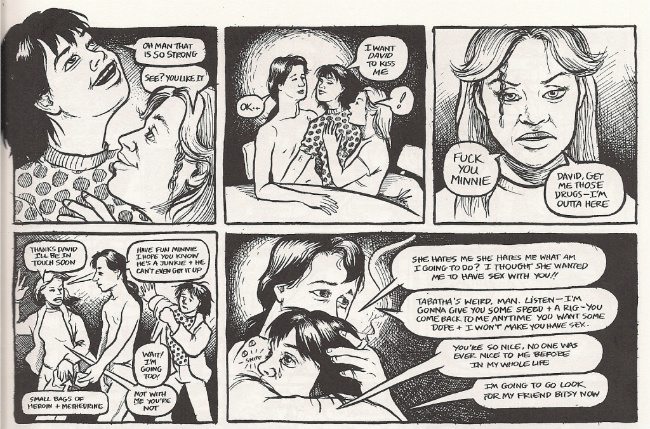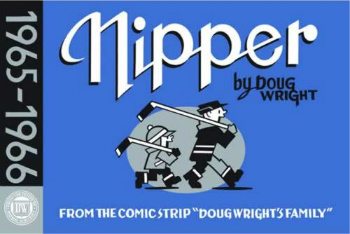Ah, the Hooded Utilitarian's Best Comics Poll: like a snow day for the weekly columnist! But I'm not gonna just list my choices and toss out a few comments, gentle reader - actually, I'm not going to list my choices here at all, since that would ruin the fun. I don't know about you, but my favorite part of these exercises (whenever they go this far) is seeing all the individual top ten lists come out, which is the main focus of this week. Totaling an overall top 10 or 115 or whatever might be more evidently an end result, but as the discussion at the immediately preceding link demonstrates, there's typically necessary consolidations and judgement calls to make, on top of the differing intents going into the formation of the individual lists. Plus, I'm pretty upset Mysterious Suspense #1 didn't make the last minute surge to the top I'd expected.
I guess I can't be objective about these things. Like many contributors, I read the "or" in organizer Robert Stanley Martin's invitational question "What are the ten comics works you consider your favorites, the best, or the most significant?" as an opportunity to plunge deep into the swooning depth of "favorites." Not a lot of my favorites landed in the overall Top 115 - I think it's just Krazy Kat and Jimbo: Adventures in Paradise as a component of Gary Panter's larger Jimbo oeuvre (which naturally, given the whole ranking aspect of a Top Whatever list, makes me feel I voted third party and threw the election to The Sandman). But anyway, a 'favorite,' to me, can carry with it a special component of personal history, serving as a waypost in some individual development.
Case in point: the 12-page short comic Minnie's 3rd Love, or: "Nightmare on Polk Street", written and drawn by Phoebe Gloeckner, originally published in the 1994 Kitchen Sink anthology Twisted Sisters II. I bought that book during a family seashore vacation when I was 15, and it is eternally alive in me as the story that showed me comics can do anything you damn well want them to. This is the first panel, depicting Gloeckner herself with some amount of humor and quickly assessing the experienced reader of the idiom the artist is working in, informed in prominent part by underground American comics so that 'cartoony' and self-referential elements coexist with explicit 'realistic' content as conveyed story-wise in an unadorned manner.
Other Gloeckner shorts (collected into A Child's Life and Other Stories) would show more of a sense of play -- one of them memorably invokes Duchamp's Étant donnés in a pair of little girls peeping on one girl's mother's boyfriend jerking off in the bathroom -- but Minnie's 3rd Love is a straight-shot account of events, its core being about a week in the life of 15-year old Minnie -- the first week of 1977 -- and what happens when she becomes infatuated with an older girl, Tabitha, who seems mainly intent on passing her younger friend around in exchange for booze and drugs.
It remains one of the most purely visceral comics I've read, though it makes some demands on the reader, particularly readers of today who maybe don't process the influence of underground cartoonists like Robert Crumb, who'd typically throw in a quick joke or a funny effect into his narratives; likewise, Gloeckner has Minnie's mouth tilt wide open as she literally pours a drink into it, not one page away from a heavily realist depiction of a man, erect prick jutting into the panel from the right, removing a tampon from the girl's naked and unconscious body.
The difference with Gloeckner is her skill at dialing the level of detail in character's forms in and out as they draw 'closer' to the reader, so that they're like cartoons when drawn small (whether standing in the background or enclosed in tiny panels so as to emphasize movement or activity) and disquietingly realistic when it seems they might be touched by the reader. This creates some thematic meaning, as well as a tension between abstraction and depiction, as a huge lump in a boy's pants with sunshine lines beaming out of it is, as depicted, the same thing as a realistic penis. Gloeckner continues to pursue this aesthetic in her La Tristeza project, a photo display of handmade dolls digitally manipulated to display human facial and anatomic features, initially published as a short feature in the 2008 anthology I Live Here and currently being expanded into its own work.
Needless to say, I'd never seen anything like that when I was 15. I was certain there where things you could never show in a narrated vignette of this sort. Yet what got me even more deeply was how the artist's honed-in gaze upon her characters highlighted their most immediate emotions, which maintain primacy over the events surrounding them. You can accuse Minnie's 3rd Love of sensation, if you want; it's enormously explicit, to be sure, and defiantly prone to inserting visual jokes and funny dialogue asides, and the penultimate page even sports a climactic fight scene with a naked participant and a "POW" sound effect. Yet the events surrounding its characters don't swallow them up.
It's a love story, you see - it says it right in the title, though the reader is given the option of taking it as horror ("Nightmare on...") if they want. It's also one in a chain of stories (the 3rd Love) - an excerpt, and intent on expressing the focus its titular protagonist lavishes on the object of her affections, in the midst of everything. There's an enormous generosity to this, by the end, as Minnie and Tabitha meet by chance again in 1994, the year of the story's publication. Gloeckner does not show anything else of the aftermath to the story's events, the effects or recriminations - instead, we're given floating, scattered dialogue, small talk, stink lines, buzzing flies indications that Minnie would really like to leave rather quickly, yet surrounding two detailed faces retaining a certain affection nonetheless. Times passes, drugs wear off, bodies break down, and this, latent, is shown to survive it all.
***
PLEASE NOTE: What follows is not a series of capsule reviews but an annotated selection of items listed by Diamond Comic Distributors for release to comic book retailers in North America on the particular Wednesday, or, in the event of a holiday or occurrence necessitating the close of UPS in a manner that would impact deliveries, Thursday, identified in the column title above. Not every listed item will necessarily arrive at every comic book retailer, in that some items may be delayed and ordered quantities will vary. I have in all likelihood not read any of the comics listed below, in that they are not yet released as of the writing of this column, nor will I necessarily read or purchase every item identified; THIS WEEK IN COMICS! reflects only what I find to be potentially interesting.
***
SPOTLIGHT PICKS!
Forming: Very nice-looking 112-page Nobrow Press-published (and AdHouse Books-distributed) collection of a webcomic by Jesse Moynihan, "one epic—and irreverent—battle royal between alien gods, Ancient Greek Titans, interplanetary assassin droids, and humanity itself." Lots of pages available on his site, looks very nice. Preview; $29.95.
Nipper Vol. 2: 1965-1966: Another slim, compact (8" x 5.25") 112-page collection of lively, expressive comics by Doug Wright (by which I presume they remained lively into 1965 and 1966, though I'm sure they did, right?). Samples; $16.95.
--
PLUS!
Archie's Mad House: Another of IDW's Archie-derived collections, this time a 204-page selection of material from the copious history of the many-titled 'zany' Archie comic, 1959-82, though its first title (i.e. the one on this collection) should indicate about what they were aiming for; $34.99.
Bad Island: Your big-time book publishing comic selection for the week - a new Scholastic graphic novel by Doug TenNapel, prolific creator of self-contained fantastical adventure stories. This one sees a family stuck on a strange piece of land; $10.99 ($24.99 in hardcover).
Hellboy: The Fury #3 (of 3): In which artist Duncan Fegredo's tenure as this Mike Mignola creation's primary artist draws to a close, along with some lingering plot threads, apparently. Mignola himself is set to return as writer/artist sometime soon-ish. Other Mignola-verse items out this week are a new issue of B.P.R.D. (with co-writer John Arcudi and new artist Tyler Crook) and a new miniseries launch for the novel-based Baltimore (with co-writer Christopher Golden and artist Ben Stenbeck); $2.99.
Black Jack Vol. 15 (of 17): Yeah, when this Vertical translation project started up in 2008 I thought it was crazy-ambitious, just way too much, but - they're really gonna do it, huh? Another 304 pages of Osamu Tezuka medical adventure shorts - Book of Human Insects is the publisher's next Tezuka release, a standalone gekiga-styled '70s piece; $16.95.
Gantz Vol. 18: On the other hand, there's always this Hiroya Oku action eruption, which I haven't seen around since May. Preview; $12.99.
The Secret History #16: Because Igor Kordey is always worth a peek, and this Archaia-translated historical fantasy series has got him. Written (as always) by Jean-Pierre Pécau; $5.95
Borderline Vol. 4 (of 4): Dynamite has been putting out this mid-'90s (pre-U.S. publishing) sci-fi/crime pulp project from 100 Bullets artist Eduardo Risso since 2006, so it's worth noting its English-translated completion with this 144-page volume. Written by Carlos Trillo, introduction by Brian Azzarello; $19.99.
Vertigo Resurrected: Jonny Double: But if it's Azzarello-as-writer you like with your Risso, Vertigo's got one of its inexpensive 96-page comic book-format collections readied for a 1998 pre-100 Bullets crime comic work by the pair, actually their first collaboration; $7.99.
--
CONFLICT OF INTEREST RESERVOIR: Well, it's not on Diamond's list again this week, but it apparently showed up in a whole lot of stores last week, so keep an eye out for The Comics Journal #301, a 640-page revival of the popular superhero comics price guide. Also not on the list but very possibly prone to showing up is another Peanuts volume (1981-82) and Esperanza, a fat Love and Rockets collections (the smaller, thicker format) bringing the Jaime material right up to the start of vol. 3. EYES PEELED.











